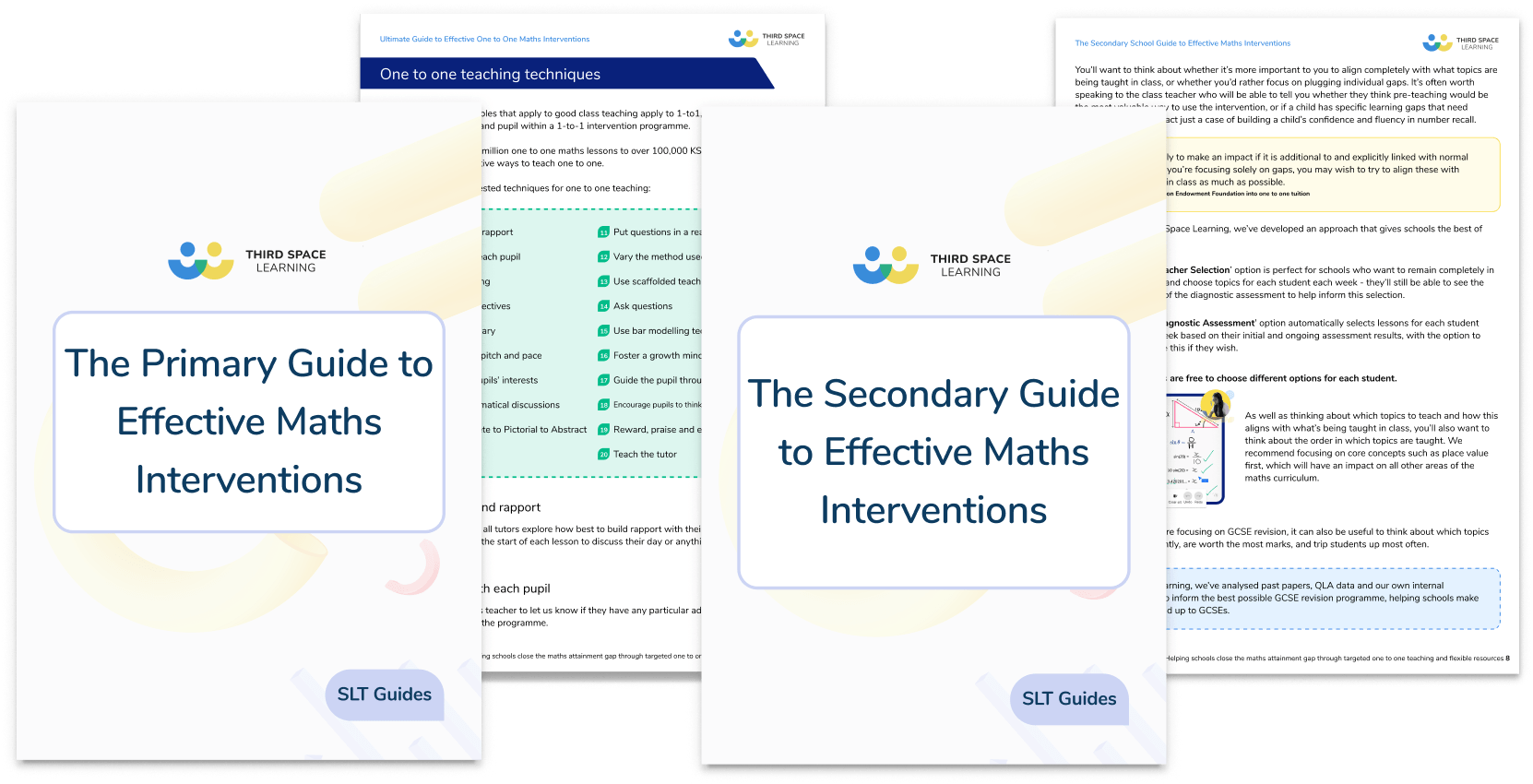9 Ways To Ensure Your Maths Intervention Is Targeted And Effective
In this article, we look at how to deliver an effective maths intervention in primary schools and secondary schools. We’ve drawn together the common threads we hear from talking with hundreds of teachers and school leaders every week, and our own experience as the UK’s largest provider of in-school AI maths tutoring.
At Third Space Learning, we specialise in one-to-one maths intervention programmes as we believe one to one AI maths tutoring is the most effective, efficient and affordable way to make rapid progress in maths. However, we understand that this isn’t always going to suit the needs of every school. Here’s a broad look at all the options available to help you implement an effective maths intervention.
What are effective maths interventions?
Effective maths interventions are periods of extra one to one or small group teaching support for pupils in addition to their daily whole class lessons.
The purpose of effective maths interventions is to help struggling learners who need additional support to make progress in maths.
The goal is usually to close the attainment gap in maths, but it can also be to:
- Accelerate the speed of pupils’ learning;
- Develop an understanding of particular mathematical concepts;
- Help pupils catch up after school closures;
- Support Year 6 and Year 11 pupils who are at risk of not meeting the expected standard in maths SATs or GCSEs; or
- Build confidence in maths.
What’s the best solution for maths interventions?
As with any intervention, maths interventions are not one-size-fits-all. Picking just one strategy from this list of maths intervention strategies that we know to be effective, just won’t work. You need a consolidated thought through approach that may involve different interventions to answer the different needs of the individual pupils who need extra support.
From early years to Key Stage 2 to Key Stage 4, maths or numeracy interventions can take many forms, from external large-scale programmes to internally resourced extra booster sessions.
For any secondary school or primary school intervention to be effective, it needs to meet the specific needs of the pupils in your school, whether that’s higher SATs or GCSE results, better number sense, improved reasoning or more maths talk.

Meet Skye, the voice-based AI tutor making maths success possible for every student.
Built by teachers and maths experts, Skye uses the same pedagogy, curriculum and lesson structure as our traditional tutoring.
But, with more flexibility and a lower cost, schools can scale online maths tutoring to support every student who needs it.
Watch Skye in actionWhat makes a maths intervention effective?
The Education Endowment Foundation (EEF) report on Improving Mathematics In Key Stages Two And Three recommended using structured interventions to provide extra support as one of the key strategies. They also emphasised that all interventions should be informed by pupil assessment of strengths and weaknesses.
The Ultimate Guide to Effective Maths Interventions
Essential step-by-step checklist to help you select, manage and evaluate the best (and most cost-effective!) maths intervention programmes for your pupils
Download Free Now!9 ways to implement an effective maths intervention
1. Use your data to choose the pupils who will benefit most
Whether it’s a summative assessment at the end of Autumn 1 or a series of formative or diagnostic assessments throughout the term that highlight the need for a maths intervention, use your data.
Start by looking at your internal assessment data and pupil premium and SEND data to identify the pupils who would benefit most from additional support. Particularly think about which pupils might not otherwise be able to access this kind of support.
In our experience, and perhaps unsurprisingly, schools tend to choose pupils in upper KS2 or KS4:
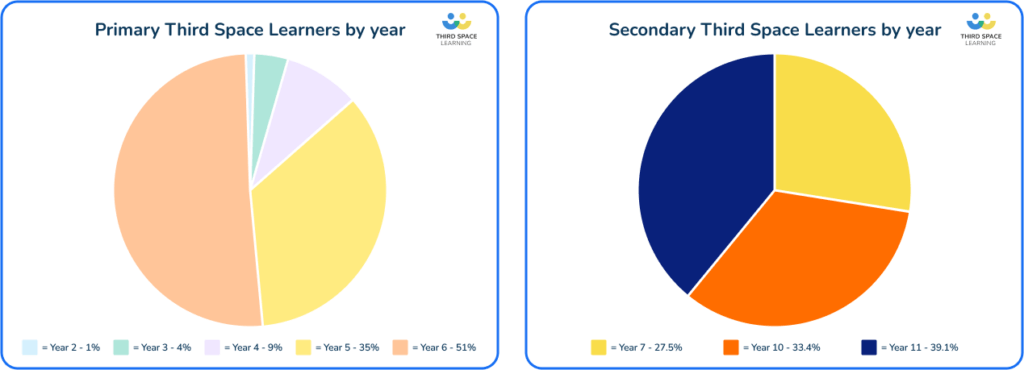
Every Third Space Learner taking part in the maths intervention programmes led by Skye, our AI tutor, starts on a learning programme chosen by their teacher. Each lesson then begins with a short diagnostic assessment – called the “Skill Check In” – to identify baseline knowledge and adapt the lesson pathway in real-time.
If the pupil shows they’re not yet secure, Skye will use scaffolded slides to teach that concept step-by-step, modelling a similar example and working through questions together before moving on to independent practice and challenge.
If the pupil shows they’re ready, Skye will skip straight to application and challenge.
Every lesson ends with a short summative assessment – called the “Skill Check Out” – to check understanding and track progress over time. This three-stage assessment process (pre-lesson diagnostic, in-lesson formative, and post-lesson summative) ensures learning is continuously personalised to each student’s knowledge gaps.
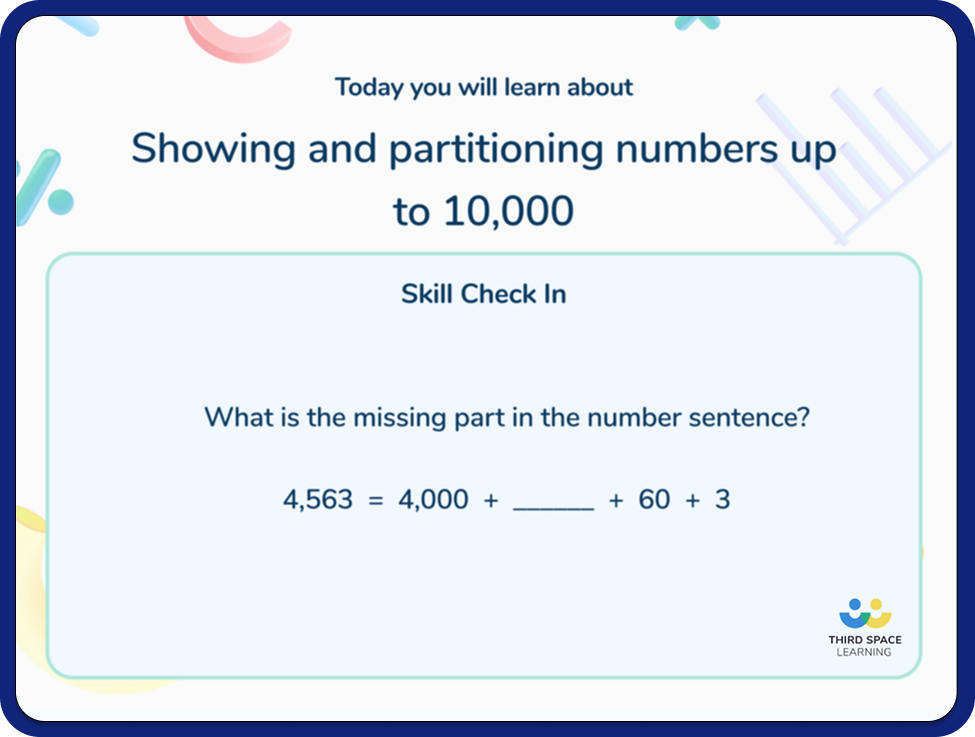
2. Define your intervention goals
These are some of the questions you should consider when defining maths intervention goals:
- Are pupils not making enough progress or do you need to support more able pupils to stretch and challenge?
- Is it a short term boost needed for SATs or GCSE or are you looking for long-term gains in confidence and attitudes towards maths?
- Is it a couple of very specific learning gaps that need plugging or is there a general need to develop an understanding of word problems and reasoning skills?
- Are there children with specific mathematical difficulties that need to be addressed with this maths intervention?
3. Plan how you’ll measure intervention effectiveness
Whether you are running interventions in-house or sourcing an external provider, you need to measure the effectiveness of your maths intervention.
An effective maths intervention programme should provide real-time progress tracking through continuous assessment. Skye’s built-in diagnostic, formative, and summative assessment gives teachers immediate insights into each student’s learning journey and knowledge gaps being addressed.
We used AI maths tutor Skye this year. 93% of our Third Space Learning pupils reached the expected level. One child, who had been struggling with maths, attained at greater depth (scaled score 110).
Deb Harris, Assistant Head, Wormley CE Primary School
If you are evaluating the softer skills of your pupils such as their confidence in maths, or an improved attitude and growth mindset, consider how any numeracy intervention programme can help you prove this.
Will case studies of individual pupils prove the intervention’s impact on pupils to your headteacher and governors?
At Third Space Learning, the “Skill Check In” diagnostic before each session enables Skye to identify the gaps in learning that need to be covered in the session. Paired with the Skill Check Out question, it also provides a baseline assessment from which to measure progress made over time.
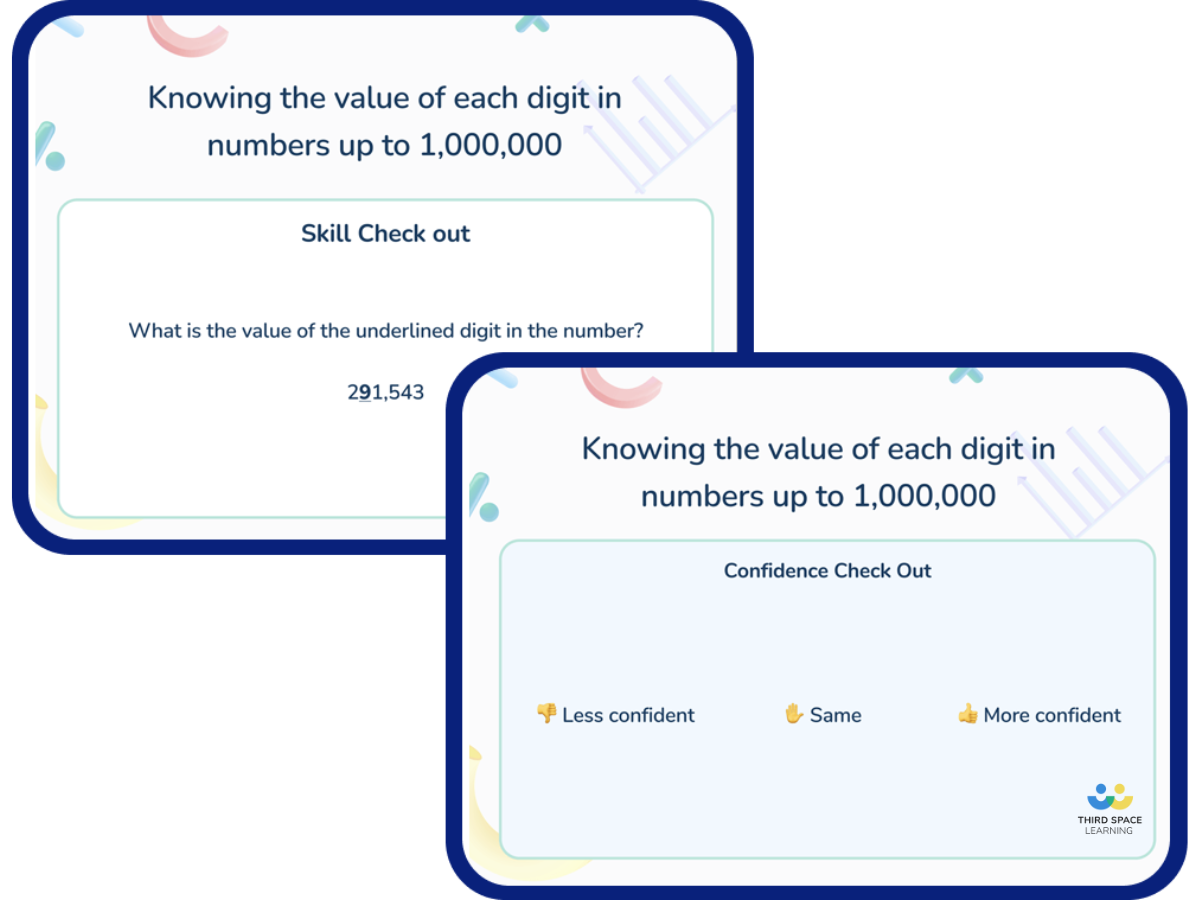
4. Early, evidence-based interventions
Many schools leave implementing consistent maths intervention programmes until Year 6 or Year 11. Often, this is too late. There are too many gaps that need filling before pupils sit their exams.
The earlier the intervention starts, the better chance a pupil has of closing the maths attainment gap and catching up with their peers and the curriculum before they sit their exams.
The opportunity to sit and talk to someone is so valuable. Particularly for kids who are shy in class because they’re scared of getting it wrong. We’ve used it in Year 5 and their confidence has improved massively. It’s great this is happening now as by Year 6 it’s almost too late.
Tim Jackson, Maths Coordinator, Pangbourne Primary School, Reading
5. Personalise learning
We’ve already established that there’s no one size fits all approach to maths interventions for how you implement them and what you teach.
Using assessment data will help you understand each pupil’s individual needs and mathematical misconceptions.
Take a granular approach and break down the data by topic and domain, and use this data to plan maths intervention lessons to ensure they are targeted. Whether it’s a focus on place value in Key Stage 1, trigonometry in Key Stage 4 or problem solving across a range of year groups, focus on what the data shows.
It’s also important to understand which type of maths intervention works best for each learner. For example, if learners have similar needs to others and work well with peers then a small group intervention may be best. Others may prefer an interactive intervention and learn best in a one to one environment. Know your pupils and provide a maths intervention tailored to them.
6. Build links between interventions and the classroom
While effective maths interventions should target the maths skills and topics each learner needs support with, it helps to link the learning to whole class lesson plans. Whether this is pre or post-teaching of the skills required to access the learning, linking interventions with whole class learning can avoid cognitive overload, support maths progress, and allow learners to build links and retain information.
Don’t waste the time of staff and pupils implementing interventions that may or may not work. Stick to tried and tested maths interventions that are evidenced based and close the maths attainment gap for at risk pupils.
7. Use evidence-based interventions
Maths interventions don’t need to be costly, many tried and tested intervention strategies are low-cost or even free, including feedback and collaborative learning.
Hundreds of schools are in a similar situation to you and there is a broad range of secondary and primary school tutoring and intervention programmes you can look at, particularly for maths. Not all of them are high-cost and many of them are proven to make the difference you need.
8. Are staff trained to run an effective maths intervention?
Any school looking to implement an effective maths intervention needs to look at its resources.
Do you have HLTAs with exceptional maths skills or maths specialist teaching staff who you can rely on to deliver additional maths support that fulfils different pupils’ needs? Consider whether you can redeploy staff to cover for these expert maths teaching staff or whether you need to provide extra CPD to staff to run a maths intervention.
Using pre-prepared resources and intervention activities such as intervention packs can help support both staff and pupils during a maths intervention.
Third Space Learning’s high-quality maths intervention packs for primary and maths intervention packs for secondary pupils are taken straight from the expertly designed AI maths tutoring programmes. Each resource pack contains curriculum-aligned lessons with visuals, scaffolded learning and support slides. Teacher notes help intervention staff prompt pupils with appropriate questions, scaffolding and methods for each learning objective.
Some schools find, with a bit of creative timetabling, and increasing use of catch-up, same day interventions they can resource the extra support their pupils need internally.
But not all schools have teaching assistants with the necessary skills and training to deliver interventions. The EEF found that interventions run by teaching assistants without appropriate support from a qualified teacher can have little impact on pupil outcomes.
9. Assess your budget and maths resources for a numeracy intervention
Any school looking to implement an effective maths intervention programme faces the challenge of having enough qualified maths specialist teaching staff to deliver additional support. Teaching assistants may lack the specific maths skills needed, while redeploying teachers creates gaps elsewhere.
This is where AI tutoring that’s been developed by maths teachers becomes a really robust solution. Skye, our AI maths tutor, provides access to specialist maths teaching without requiring additional staff training or timetable disruption. Secondary schools and primary schools can then scale structured interventions to reach every student who needs extra support.
You may also decide that teacher workload is already too high to ask staff to plan, manage and monitor a maths intervention programme.
We knew organising and running tutoring in-house was feasible but it’s a big job that would require lots of communication between staff. There was also no guarantee that we would have found enough teachers. That’s why we chose Third Space Learning. It runs so smoothly that I can let a class of 15 pupils get on with the tutoring while I get on with other tasks I need to complete.
Jon Kilbane, Deputy Headteacher and Maths Lead, St Michael’s Primary School, Reading
Many schools use pupil premium funding for their maths interventions, as these are often the children who need the help most.
However, if you’re also targeting non-pupil premium children, you will need to consider how you can fund any maths intervention programme or support them without spending money. What unspent budget can you locate?
One of our guiding principles with the AI tutoring has been to make it suitable for school budgets even in this challenging climate. What this means for schools is that even if you use your pupil premium funding to pay an AI tutor, it’s one fixed cost with no per session limits, so you can include any number of pupils on this maths intervention. And it’s available to use at home as well as at school.
Most providers, including Third Space Learning, are happy to agree a plan that fits an individual school, a group of schools or a multi academy trust budget.
Before you choose your maths intervention, speak to all the relevant staff members (headteachers, maths co-ordinators, other year group teachers, business managers) to establish what additional benefit they might derive from any maths intervention you choose.
While using your own staff might seem cheapest initially, AI maths tutoring often provides better value when you factor in unlimited access, no staff redeployment costs, and no timetable disruption.
Once you know your budget you will have a better idea of what’s available to you and what the pros and cons might be.
Four considerations when choosing an effective maths intervention programme
When researching available maths interventions for your school, consider the impact you would like your interventions to have and which maths intervention will best support your pupils.
For example, if an intervention requires laptops or the internet and you know that your wifi connection only works in the morning or a certain area of the school, factor this in when you’re selecting the intervention. Be prepared to be flexible.
Ask questions in Facebook groups or on Twitter. Get a first-hand feedback from teachers and head teachers. Third Space Learning’s impact report, case studies and reviews like this one provide an idea of what to look for from providers.
Talk to other schools, attend maths showcases, or even education speed dating sessions. The great advantage of such local events is that often schools near you will have similar contexts and face similar challenges.
And don’t forget to refer to the EEF toolkit for an overview of the effectiveness of intervention strategies in schools.
One to one tuition, for example, is proven to make +5 months’ additional progress but some providers are quite costly. At Third Space Learning, we’ve managed to reduce costs to schools by delivering the maths interventions online and leveraging the power of AI so students can still receive the benefits of one-to-one tutoring.
With Skye we provide unlimited AI maths tutoring for one fixed annual cost making one to one support accessible to every student who needs it.
For a short period, Third Space Learning are offering free trials of the AI maths tutor which is an excellent way to test out the intervention for your pupils.
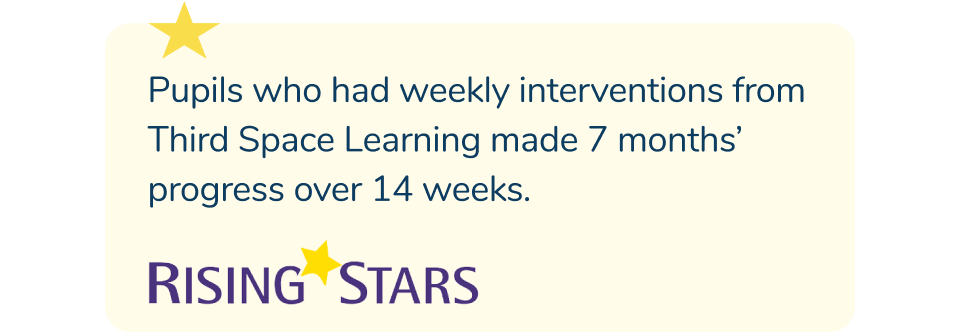
1. Do they maximise intervention impact?
Any effective maths intervention provider should have enough experience of the different ways schools have interacted with their intervention to be able to highlight how to get the most out of it, or indeed what challenges you might face.
Make sure any maths intervention programme aligns with the teaching strategies and learning strategies pupils experience in their whole-class lessons. Providers should adapt their teaching to match your calculation policy or maths scheme of work.
Consider how the intervention impacts pupils’ attitudes to maths. Helping to build confidence and developing a growth mindset in maths will have long term benefits for years to come.
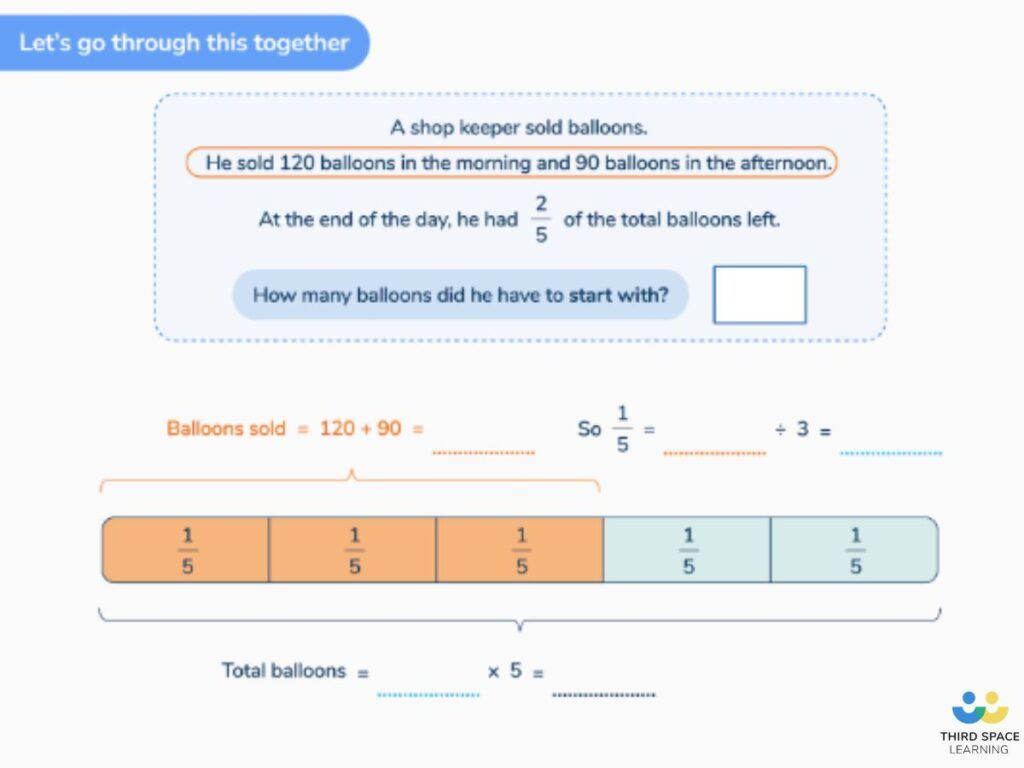
2. Children not receiving numeracy interventions
Try to ensure that your maths intervention has as wide-reaching an effect as possible.
Third Space Learning aims to help raise attainment across the schools we work with, not only for pupils receiving tutoring. In addition to the sessions, schools have access to our toolkit of high-quality teaching resources, assessments and online CPD through the Maths Hub for primary schools and the Secondary Resource Library for KS3 and KS4.
Schools and teachers can still access our primary and secondary maths resources without being signed up for tutoring, but primary schools signed up for tutoring receive premium Maths Hub access at no additional cost.
3. The maths intervention programme pedagogy
As a teacher or school leader, you’ll know what effective teaching looks like. To help you ascertain if your maths intervention programme is developed and tested appropriately for maximum success, check if it incorporates some of these essential maths strategies:
- Recap prior learning
- Use and share the correct maths vocabulary
- Create opportunities for math talk
- Questioning
- Develop metacognition
- I do, we do, you do
- Praise and effective feedback (including assessment for learning)
4. Common maths intervention challenges
Organising and running a maths intervention programme that effectively supports pupils isn’t easy. These are some of the most common challenges schools tell us they face:
- Supporting specific groups e.g. SEN and EAL pupils effectively
- Managing and allocating the school’s budget, particularly pupil premium funding, to afford interventions
- Providing a quick, intensive boost for SATs and GCSEs
- Time and resources to plan and deliver interventions
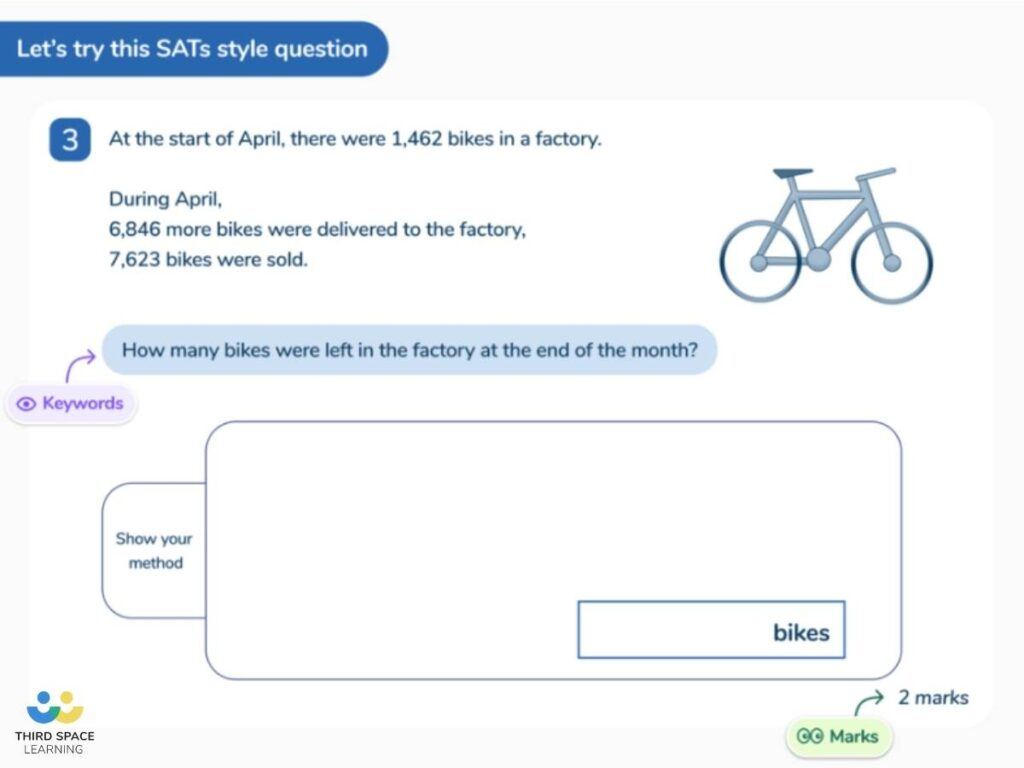
Your school may face these or other challenges. They’re normal! The important thing is to be aware of the challenges and risks before you commit to your secondary school or primary school intervention programme. Have a plan in place to combat any foreseeable future problems.
Which sort of maths intervention should you choose?
With the the Covid-19 pandemic still impacting pupil’s education, the DfE is clear that research has found that one to one tutoring is the most effective way to support children who’ve fallen behind. That said, schools have a choice of different maths intervention approaches.
Aside from using intervention teachers (who can be expensive) or TAs (who may not be best qualified), these are the three most popular types of external maths interventions that schools use.
In each case, you need to carefully consider your cohort’s and your school’s needs to choose the maths intervention programme that’s right for you.
1. Maths websites and online resources
These maths websites are easily accessed and used as a standard “go-to” numeracy intervention when teachers want to provide additional help but don’t have the time to plan structured and individualised learning interventions.
Benefits:
- They are usually quite cheap
- Often, these interactive websites are fun in the short-term
Disadvantages:
- Children can become disengaged and their learning may not be maximised
- Generic websites don’t necessarily tackle the root of any maths misconceptions
- Personalisation is often fairly rudimentary and ‘broad brush’ e.g. a child will be offered harder or easier questions to do but they are not necessarily based on the child’s gaps or misconceptions
2. One to one or small group face-to-face maths tutors
Many teachers report to us that one to one specialist maths tutors would be the intervention of their choice if budgets were unlimited. However, for most schools, an intensive personalised numeracy intervention seems out of reach.
Benefits:
- One to one tuition is a highly effective way to accelerate progress in maths.
- Lessons are fully personalised to the needs of the pupil
- Pupils can ask questions and talk through their understanding at their own pace
Disadvantages:
- Face to face one to one tuition is often expensive
3. Online one to one maths tuition
At Third Space we recognise that 1-to-1 maths tuition is a great solution for most pupils, but it is often time-consuming and costly. So we’ve taken insights from 2,100,000 online one-to-one maths tutoring sessions in schools and developed Skye, the conversational AI tutor who can teach as many pupils as need support in your school, any time they need it.
This is not chatbot tutoring. It’s real-time mathematical discussions with a specially trained tutor for a fraction of the cost of traditional one-to-one tutoring.
Pupils have their own personal maths specialist tutor for the term.
Benefits:
- All the personalisation benefits of one to one tutoring but unlimited access
- Diagnostic assessment creates individualised learning pathways
- Available for unlimited students simultaneously
- Significantly more affordable than traditional tutoring
- No staffing or scheduling constraints
- Built by teachers using proven pedagogy
Skye, our AI maths tutor, delivers the same structured interventions and personalised approach as human tutors, but removes the barriers of cost and scale that prevent many schools from providing one to one support to every child who needs it.
In addition to practising maths concepts in 1:1 sessions, children have time and encouragement to explain their answers and justify their reasoning, which helps them on their journey to maths mastery.

Disadvantages:
- It could be tricky for children below the age of about 6 or 7 as they need to be able to sit and communicate for 45 minutes with a tutor.
- Online one to one maths tuition is not suitable for some children with additional needs who need a full time TA with them.
What next?
Armed with your intervention checklist and some background on the interventions available, you’re now ready to take the necessary steps to improve maths attainment for your pupils.
It is our belief that Third Space Learning’s maths intervention is the most effective way to accelerate pupils’ progress in maths, and the thousands of schools we work with every year are our evidence.
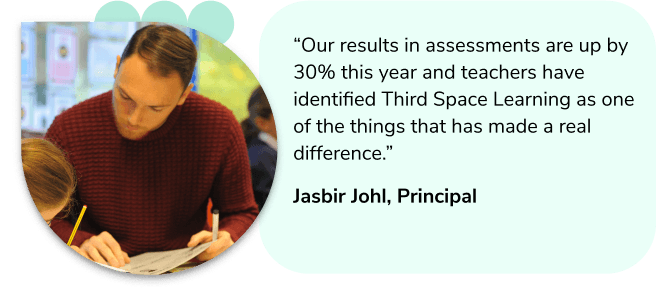
But you will need to do your own research at this point to decide what is going to work best for your school. A good place to start is by reading reviews from other schools.
When you’re ready, book a 5 minute phone call with one of our extremely friendly schools team and see if Skye, the AI maths tutor from Third Space Learning, is right for your school. Free trials available.
DO YOU HAVE STUDENTS WHO NEED MORE SUPPORT IN MATHS?
Skye – our AI maths tutor built by teachers – gives students personalised one-to-one lessons that address learning gaps and build confidence.
Since 2013 we’ve taught over 2 million hours of maths lessons to more than 170,000 students to help them become fluent, able mathematicians.
Explore our AI maths tutoring or find out about maths intervention programmes for your school.



